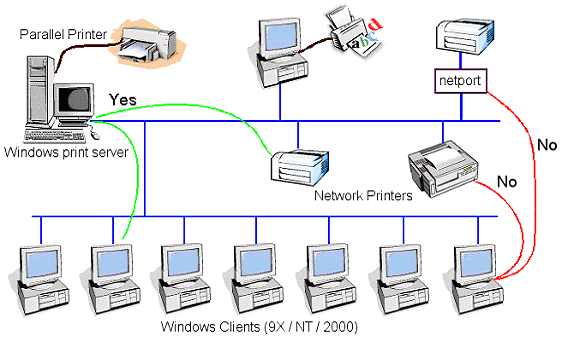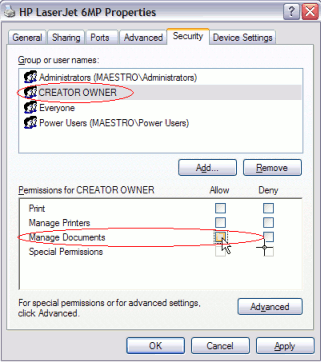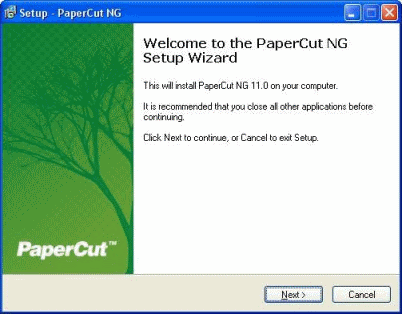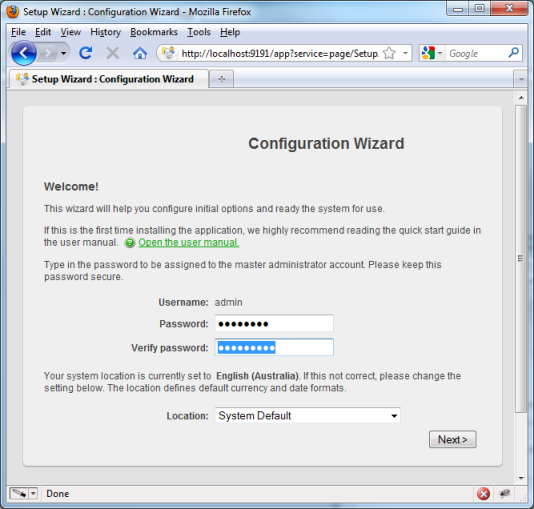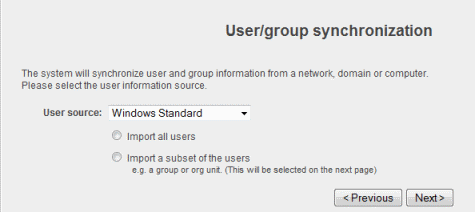Table of Contents
- Installation on Windows
- Installation on Apple Mac
- Installation on Novell OES Linux (iPrint)
- Step 1 - System Requirements & Printer Setup
- Step 2 - Create the host user account and firewall settings
- Step 3 - Download and installing
- Step 4 - Configuration Wizard
- Step 5 - Printer/iPrint Configuration
- Step 6 - Sharing Client Software
- Step 7 - Testing
- Step 8 - Deployment for a Professional (Client Billing) Installation
- What next?
- Installation on Linux (CUPS and/or Samba)
- Step 1 - System Requirements
- Step 2 - Create the host user account and firewall settings
- Step 3 - Download and installing
- Step 4 - Configuration Wizard
- Step 5 - Printer Configuration
- Step 6 - Sharing Client Software
- Step 7 - Testing
- Step 8 - Deployment for a Professional (Client Billing) Installation
- What next?
- Testing the Installation
This chapter covers the initial installation and configuration of PaperCut NG in your network environment. Initial installation takes only a few minutes on a currently configured server. This guide will walk you through installation and configuration step-by-step. The process is summarized below:
System requirements check
Downloading and installing PaperCut NG
Completing the configuration wizard
Testing client software
Testing printing and remote access
PaperCut NG is a cross-platform solution and the installation procedure will vary depending on the target operating system(s). Please jump to the appropriate section below:
For additional information on setting up the optional Internet Control module see Chapter 15, Net Control in Detail.
Important
This guide assumes that you are using Windows Server 2003. The process is similar for other Windows operating systems such as XP, Server 2008 or Vista.
If you're upgrading from a previous PaperCut NG version, please refer to the directions outlined in Appendix F, Upgrading From a Previous Version.
Before installing PaperCut NG for either evaluation or production use, the system administrator should take a few minutes to verify system requirements.
Is the operating system version supported and patches up-to-date? Take a few minutes to verify the system is current and supported (see the section called “System Requirements”).
In workgroup environments (i.e. where no domain is present), some additional configuration may be required. For more details see Chapter 28, Running in a Workgroup Environment.
Are printer(s) installed and hosted on this system? PaperCut NG needs to be installed on the system directly hosting the printer(s). The printer should be installed as a "Local Printer" with a connection method such as TCP/IP Port, LPR, or JetDirect or directly connected to the system via USB or LPT Port.
In a multi-user environment, printers are often shared with other network users. Other workstations should connect to these printers as "Network Printers". Ensure workstations are configured to print to the shared print queues. For example a Windows workstation may connect to a printer via a path like:
\\[samba_server]\[printer].Ensure that printers are configured correctly and work before installing PaperCut NG.
Important
If you are running the PaperCut NG server on Windows XP (Professional) you must disable "Simple file sharing". For more information please see Appendix B, Troubleshooting & Technical FAQ's.
If you are running a Windows workgroup network or using Windows XP/Vista Home workstations, please see Chapter 28, Running in a Workgroup Environment.
When using release stations or account selection popups it is recommended to secure the print queue so that users do not have permission to pause/resume documents in the queue. This allows PaperCut NG to have full control of documents without interference from users. To do this:
Log onto the server hosting the printers as an Administrator.
Open the printer configuration screen: →
Right-click a printer and select Properties.
Select the Security tab.
Select the CREATOR OWNER user and uncheck the Manage Documents permission. See Figure 2.2, “Configuring Windows print queue permissions”
Press the OK button.
Perform these steps for each of the monitored printers.
Tip
A tip from one of our customers Chris, is when using Windows 2008 Server is to use the Server Manager, navigate to the Print Management Console and globally set the security permissions by right-clicking the → → and editing the permissions there.
Windows Server 2008 R2 installations may experience an issue where print jobs are not removed from the print queue when completed. These jobs stay in the queue with a status of 'Sent to Printer'. To work around this you will need to configure the Printer Driver Isolation so that jobs are removed from the queue when completed.
Log onto the server hosting the printers as an Administrator.
Using the Server Manager, navigate to the Print Management Console: → → → → → →
Right-click a printer driver and select → .
Perform these steps for each of the monitored printers drivers.
PaperCut NG is supplied as a standard Windows setup.exe install program.
The latest version may be downloaded from https://www.apms.com.hk/. This installer automatically
detects whether your operating system is 32 or 64-bit and installs a version of the software optimized for
your system. After the download is complete, run the setup wizard as an administrator level user. A system
restart is usually not required but administrators are advised to perform installation on live production
systems during periods of low activity - for example, not during backup operations or other administration activities.
Select the "Standard installation (primary server)" option and install PaperCut NG onto a hard drive with adequate free disk space. The default options will suffice for most systems.
After installation, the install will open a web browser window. The configuration stages are explained below:
This is the master password for the main in-built admin account, and is independent of the operating system or domain passwords. The password will need to meet minimum strength requirements, and must be at least six characters. Ensure that knowledge of this password is kept secure. This screen also sets the system's physical location and language; ensure that these are correct before proceeding.
Tip
Treat this password like your router/modem management passwords. It is independent of your domain accounts and needs to be kept secure.
This is the organization type which matches the organizational environment where PaperCut NG will be used. Choosing the appropriate organization type will determine which system defaults are used on setup. For example, in a Professional (Client Billing) organization, where it is useful to charge-back printing to customers, an advanced client popup is provided with additional features useful for dealing with large numbers of client (shared) accounts. These default settings chosen for an organization type can be changed after installation.
This is the default cost-per-page assigned to the printers. This setting can be changed on a per-printer basis after installation. Choosing a sensible cost now will help minimize future setup. For example in the USA, a value of $0.05 would be appropriate for many standard black & white printers.
When the organization type has been set to Education, users can be assigned an initial starting credit. This ensures they have funds in their account as soon as the system is enabled. An option also exists to control what happens when users run out of credit/quota. If you are evaluating PaperCut NG it might be appropriate not to disable printing when a users funds run out. This way you can be assured that user printing is not disrupted during the evaluation. These settings may be changed after setup.
PaperCut NG extracts user information out of the System or Domain. The options presented here will vary depending on the Operating System and its environment. During evaluation, most sites will opt to import all users from the system/domain into PaperCut NG. An option also exists to import a subset of users from a given group. This option is pertinent when it is known that only a subset of users will only ever use the printers.
Options on Microsoft Windows include Windows Standard, Active Directory, or LDAP. In a domain enviroment, Active Directory is the default option as this offers access to Organization Units, Nested Groups and other AD features.
Use the to test and confirm your settings before continuing.
In a Professional (Client Billing) environment, the main focus is on allowing users to allocate print jobs to client (shared) accounts. The process works by:
Pausing all jobs that enter the print queues.
Displaying a popup on the user's workstation asking them to allocate the print job to an account. This is done by selecting the account from a list.
After the user has responded to the popup, the job is released to the printer.
You can read more about the account selection process and shared accounts at Chapter 8, Shared Accounts.
The account selection popup option is enabled at the user level. Once the option is enabled, the user must run the client software. If the client software is not running, the popup cannot display, and the job will remain paused in the print queue. This option is hence considered high impact. You are presented with two strategies that allow you to choose the implementation approach that best suits your needs:
In this strategy the account popup is only initially enabled on a single user for testing. You need to nominate the testing account; this may be an existing system/domain account used for testing purposes or even your own user account. The username should be in the format used to log into the domain/system (usually the short form).
The minimal impact strategy will allow you to test the popup with the nominated test system/domain user account, after which the Advanced Account Selection Popup option can be enabled for other users as appropriate.
This strategy enables the account selection popup on all users, and is often preferred for smaller networks as it minimizes the required post-install configuration. Once the client has been deployed, the system will be operational. If this option is selected, you should be prepared for installation of the client software to user desktops (see Step 7) immediately to prevent disruption of user printing services.
If in doubt, select the minimal impact strategy. This will ensure the impact is isolated to only the nominated test account.
Prior to enabling the configuration options that you have selected, you will have the chance to verify setup options. At this stage you are still able to return to any of the prior configuration screens to alter options before clicking .
After completing the configuration wizard you will be presented with a user synchronization status screen, showing the progress and results of the system completing its initial setup. Once you have closed that, click to access the interface and begin familiarising yourself with the options and features available. Take some time to explore, and refer back to the relevant sections of this manual as required.
The printers should be automatically detected, and listed under the Printers section. If the printers do not display, try printing a document as the first job will trigger registration.
The PaperCut NG client software is located in the directory [app-path]/client. This
software needs to be shared over the network so workstations can access/install the client application.
The directory is automatically shared in read-only form as PCClient
as part of the install process. Confirm that you can access the client software via the network
by browsing to \\server\PCClient.
The PaperCut client software may now be deployed if required. The client software is not required for basic print tracking and reporting. Some features the client software provides include:
Displays notification messages, such as why a print job was denied.
Displays print policy popups, such as to encourage duplex printing.
Displays popups for shared account allocation/charging (department accounts, client billing).
Allow the user to confirm the details and/or cost of their print job before printing.
Shows the user their current balance (useful in schools where print quotas are used).
Can be used for authentication when printing from public terminals or other unauthenticated systems.
For a professional (client billing) installation the client software is required so that users can allocate print jobs to client (shared) accounts via a popup. It is recommended to follow the steps in the section called “User Client Deployment” for best practice client deployment methods. After the client software is deployed you may then enable the account selection popup for all users as discussed in the section called “Enabling the Advanced Account Selection Popup For All Users”.
For other installation types the client software is optional. If you choose not to deploy the client software you may still choose to deploy it in the future.
For more details about the client software see the section called “User Client”. For details about deploying the client software see the section called “User Client Deployment”.
Following a fresh installation, it is highly recommended to test core features of the system. For further details please see the section called “Testing the Installation”.
This concludes the Install Guide. You may like to take some time to explore the features of PaperCut NG before continuing reading at Chapter 3, Implementation by Example or Chapter 4, Quick Tour. Business users may be particularly interested in trying the popup client software as covered in the section called “Client Software”. If desired, the client software should also be deployed to other workstations. This procedure is detailed in the section called “User Client”.
To set up the optional Internet Control module, see the instructions in Chapter 15, Net Control in Detail.
